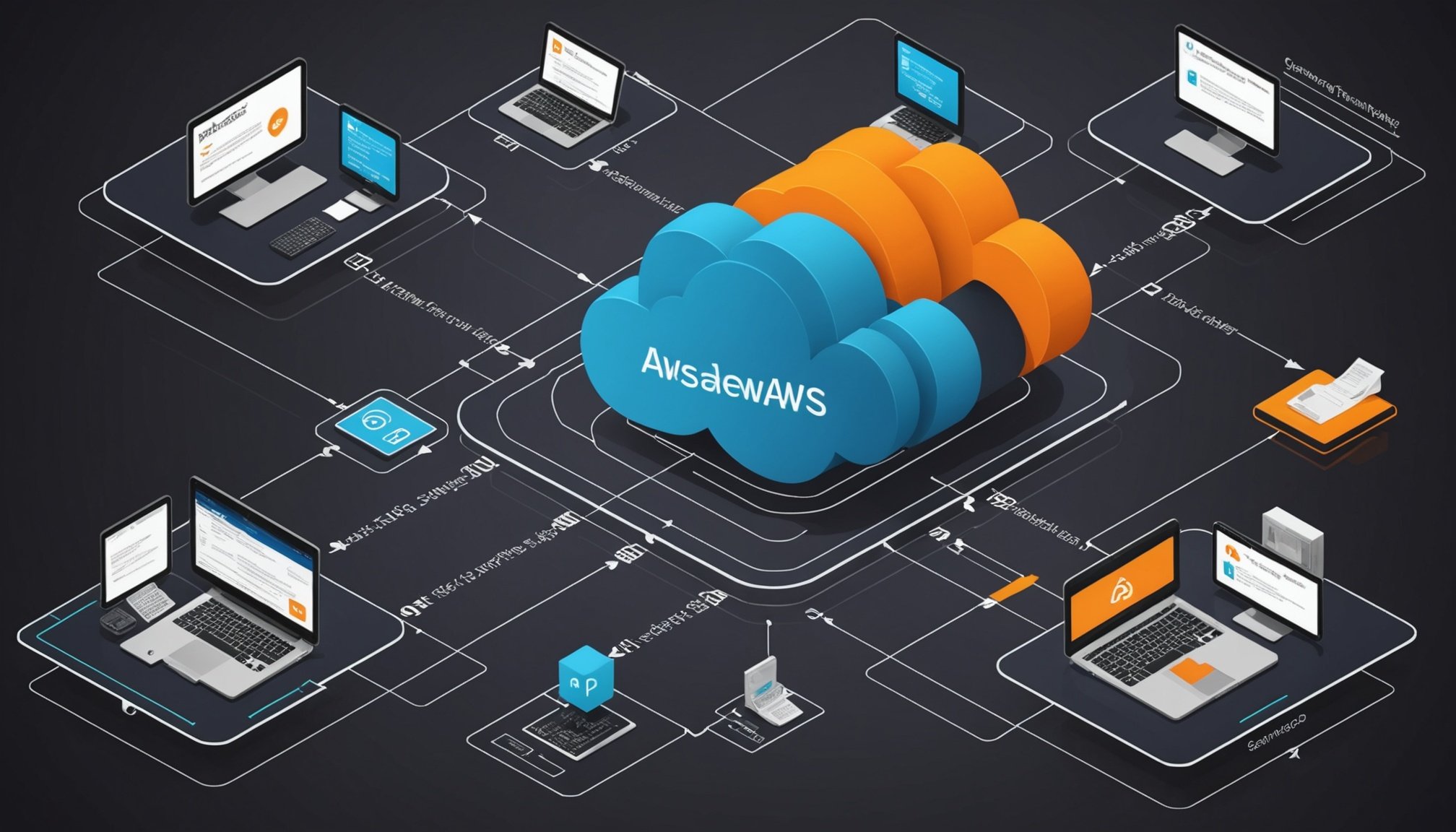Overview of AWS Step Functions
AWS Step Functions is a robust service designed to arrange and execute serverless workflows efficiently. In the realm of serverless architectures, Step Functions shines by simplifying workflow management through its ability to coordinate distributed systems and automate service orchestrations. This beneficial tool eliminates the cumbersome process of managing complex workflows manually by leveraging automated workflows that coordinate microservices.
One of the significant benefits of AWS Step Functions lies in its modular approach, which enhances scalability and fault tolerance. By dividing workflows into independent components called states, you can ensure that each transition is precise and managed with greater ease. Furthermore, the flexibility of serverless workflows allows you to easily modify, repeatedly test, and deploy workflows without affecting underlying infrastructure.
Have you seen this : Mastering AWS Elastic Beanstalk: The Ultimate Guide to Seamless Deployment and Management,slugslug
When talking about key components, it is vital to understand the terms associated with AWS Step Functions, such as state machines, which define sequences of states, and tasks, which represent units of work performed by states. The terminology extends to choices, enabling conditional branch logic, and parallel states that allow simultaneous execution. This comprehensive appliance of terminologies underlines why AWS Step Functions is a favoured choice for managing distributed workloads effectively.
Overview of AWS Step Functions
AWS Step Functions is a workflow management service designed to help developers handle the orchestration of serverless workflows effectively. It plays a vital role in serverless architectures by enabling users to build applications quickly using visual workflows. These workflows coordinate different services such as AWS Lambda, and integrate with various AWS functionalities to achieve streamlined operations.
In parallel : Unlocking AWS Kinesis: Your Ultimate Guide to Mastering Real-Time Data Streaming Success
One of the key benefits of using AWS Step Functions is its ability to manage complex workflows. It offers features such as built-in error handling and state management, allowing users to easily monitor, execute, and recover workflows. This results in a simplified and efficient way to manage and scale processes without extensive manual intervention.
The service revolves around several critical components such as state machines, which represent the workflow definition, and a set of states that define each step within the workflow. These components provide a clear structure where users can monitor executions and ensure seamless transitions between different tasks.
AWS Step Functions also support serverless workflows, which enable automatic scaling and pay-per-use features. This contributes to faster development cycles and improved resource utilization. Additionally, as workflows can be modified without affecting the application’s core operations, AWS Step Functions provide adaptability and resilience essential for modern business environments.
Setting Up AWS Step Functions
Setting up AWS Step Functions is a crucial process that starts with configuring the AWS console. Begin by navigating to the AWS Management Console and selecting “Step Functions” from the services list. It’s essential to establish the right IAM roles to ensure proper permissions, allowing Step Functions to communicate with other services. This can include read/write permissions and access to AWS Lambda, necessary for serverless configuration.
In this setup, outlining your state machine is paramount. Begin by defining the types of states you will use, such as task, choice, and parallel states for complex workflows. These configurations must align with your workflow objectives.
Be wary of common pitfalls: ensure that input/output data is correctly configured between states to prevent execution errors. Misconfigurations in state definitions or transitions can cause workflow failures, thus double-checking syntax and logical flow is advised.
Lastly, invest time in understanding the pricing model. AWS Step Functions charges per state transition, so optimize your state machine to minimize costs. By following these foundational steps, you are well on your way to efficiently managing serverless workflows through AWS Step Functions.
Setting Up AWS Step Functions
To start with AWS Step Functions setup, access the AWS console, where you’ll navigate through initializing your workflows. The process begins by choosing ‘Step Functions’ under the ‘Services’ tab. A pretty straightforward entry!
Critical to serverless configuration is setting the correct roles. You must establish IAM roles with permissions that allow Step Functions to interact with other AWS services securely. This will ensure your workflows run without interruptions. It’s a common pitfall to overlook permissions, leading to those annoying access issues.
During setup, defining your state machine is essential. Each state within the machine dictates specific tasks or decisions. For tasks, integrating related services using predefined connectors can enhance workflow efficiency. Take care—it’s easy to misstep by incorrectly defining state transitions or conditions, which might result in undesired workflow execution paths.
Always double-check configurations against your intended workflow structure. Using the visual tool for state machine designs offered by AWS can help catch errors early in the setup process. Remember, avoiding these pitfalls initially saves time troubleshooting later.
Case Studies of Successful Implementations
AWS Step Functions has proven its worth across various industries by streamlining complex workflows and enhancing operational efficiency. One notable success story involves a healthcare provider leveraging Step Functions to automate patient data processing. By integrating with AWS Lambda, they achieved swift data validation and routing, reducing errors and operational costs.
In finance, a prominent bank adopted AWS Step Functions to handle loan application workflows. By replacing manual processes, they increased processing speed and reliability. The ability to implement parallel processing allowed simultaneous credit checks and document verifications, resulting in faster loan approvals and improved customer satisfaction.
A technology company harnessed AWS Step Functions for real-time data analysis. With its state machine capabilities, they orchestrated data collection from IoT devices, providing quick insights and alerts. This resulted in timely decision-making and reduced downtime.
These examples illustrate not just the effectiveness but also the versatility of AWS Step Functions. By carefully designing state machines and leveraging AWS Lambda integration, businesses can automate tasks, handle errors efficiently, and optimize resource use. Each case highlights the importance of tailored workflow design in meeting specific industry challenges, leading to substantial operational improvements and cost savings.
Building Complex Workflows with AWS Step Functions
When crafting sophisticated workflows, AWS Step Functions excels through its advanced workflow design capabilities. At the heart of this design are state machines which are pivotal in managing the flow of actions based on conditions and sequences. State machines, therefore, provide a clear map for operations, ensuring that tasks are executed smoothly and efficiently.
One of the defining strengths of AWS Step Functions is its seamless AWS Lambda integration, enabling automated tasks. This integration simplifies executing serverless functions, allowing developers to chain complex logic into workflows effortlessly. AWS Lambda enriches the workflow by executing code in response to state transitions, making the process agile and responsive.
Moreover, AWS Step Functions supports parallel processing, crucial for operations requiring concurrent task execution. This feature reduces processing time and enhances the capacity to handle large, complex workflows by allowing multiple tasks to run simultaneously. Alongside this, error handling mechanisms are embedded, making it easier to identify, manage, and recover from process disruptions without manual intervention. These built-in features make AWS Step Functions an indispensable tool for designing robust, scalable workflows in a serverless infrastructure. Through intelligent design and automation, it significantly improves operational efficiency and architecture resilience.
Best Practices for AWS Step Functions
Navigating AWS Step Functions requires adopting AWS Step Functions best practices for efficiency and cost savings, especially in complex workflows. Optimizing performance begins with cost optimization—mindfully structuring state machines to minimize unnecessary transitions. Consider utilizing parallel states without inflating costs by intelligently designing tasks that can run concurrently.
Simplicity and clarity in workflows are equally critical. Avoid overcomplicating designs by maintaining a logical sequence of states, ensuring that each state’s purpose and transition are intuitively understood. Achieve efficient workflows by leveraging modularity within state machines. This approach provides adaptability, allowing quick updates without complete overhauls.
Monitoring and logging are indispensable for effective workflow management. By implementing robust logging and monitoring, you gain valuable insights into state transitions and execution timelines, helping identify performance bottlenecks swiftly. AWS CloudWatch offers tools for seamless integration, ensuring you can track workflow metrics diligently.
Maintaining an efficient and cost-effective setup of Step Functions not only enhances performance but also reduces operational costs dramatically. Employing these best practices fosters not only better development agility and resource utilization but also strengthens your application’s resilience and scalability in line with business objectives.
Comparing AWS Step Functions with Other Workflow Tools
In the realm of workflow management, choosing the ideal tool is crucial. AWS Step Functions stand out for their seamless integration with other AWS services and their support for complex serverless workflows. However, understanding other workflow tools is essential for informed decision-making.
Alternative Workflow Tools
Several alternatives exist, each offering unique features. For instance, Google Cloud Composer utilises Apache Airflow, providing strong capabilities for directed acyclic graphs. Microsoft Azure Logic Apps is another contender, suitable for business workflow automation with its rich connector library. Both tools, like Step Functions, allow integration with their cloud ecosystems, ensuring broad workflow management options.
Pros and Cons
AWS Step Functions offer exceptional scalability and fault tolerance through their state machine architecture. These aspects can make AWS Step Functions preferable for serverless architecture enthusiasts. Conversely, alternatives might be more fitting for businesses deeply invested in non-AWS environments or those requiring specific integrations outside AWS.
User Experience and Pricing
While AWS offers a comprehensive graphical interface, tools like Azure Logic Apps provide user-friendly, drag-and-drop features. In terms of pricing, Step Functions charge based on state transitions, whereas competitors might have varied cost structures. Understanding these variables ensures businesses can align tools with their operational and financial parameters efficiently.
Comparing AWS Step Functions with Other Workflow Tools
When it comes to workflow management, businesses often evaluate multiple options to determine the most suitable solution for their needs. In the realm of workflow tools comparison, AWS Step Functions finds its place among various alternatives, each offering distinct strengths. Consider AWS Step Functions offers a serverless, scalable approach ideal for complex task orchestration, seamlessly integrating with AWS services like Lambda.
Other notable workflow management options include Apache Airflow, which provides strong scheduling capabilities and a robust web interface. Prefect, another competitor, champions ease of use with its Python-based orchestration, offering less vendor lock-in compared to AWS.
Pricing often becomes a crucial factor in these decisions. While AWS Step Functions applies a per-state transition cost-benefit, it can efficiently optimize cost if designed proficiently, despite potentially becoming expensive for extensive workflows. By contrast, Airflow’s open-source model presents a cost-effective solution albeit requiring more operational overhead.
AWS alternatives might cater to specific user preferences or existing infrastructures. However, AWS Step Functions shines in user experience via its intuitive design and rich documentation which fosters smooth adoption. This consistent integration with the AWS ecosystem makes it a favorable choice despite potential cost implications. Strategically evaluating these factors empowers informed decision-making when selecting a workflow management tool.
Future Trends in Workflow Automation with AWS
As technology advances, workflow automation within AWS is poised to undergo significant changes. A noticeable trend is the emergence of machine learning and AI in automating complex processes. These intelligent systems can enhance AWS Step Functions by analysing large datasets in real time, thereby optimizing decision-making capabilities. The integration of AI enables prediction of workflow outcomes, allowing more proactive management of resources and tasks.
Future developments will also spotlight the continued expansion of serverless architecture. With AWS continually improving its serverless offerings, workflows are expected to become even more scalable and efficient, reducing the reliance on traditional infrastructure. This shift will allow for quicker adaptation to business needs, removing bottlenecks typically associated with physical IT resources.
Cloud trends indicate an increased emphasis on security and compliance within automated workflows. As data regulations grow stricter, AWS Step Functions must evolve to enhance secure data handling and ensure compliance across regions. Incorporating robust security protocols will be key to remaining globally competitive.
Finally, the rise of edge computing presents opportunities for AWS Step Functions to extend automation capabilities closer to where data is generated. By processing data nearer to its source, latency is minimized, further elevating workflow efficiency and responsiveness in dynamic environments.
Troubleshooting Common Issues in AWS Step Functions
Working with AWS Step Functions can present challenges even for experienced users. Common issues, such as state transitions not behaving as expected or permissions error, often arise. Identifying these common errors is the first step to effective troubleshooting. It’s crucial to scrutinise your IAM permissions, ensuring the necessary roles with adequate rights are in place. Often, these configuration oversights lead to execution failures.
Workflow debugging involves using specific AWS tools to rectify problems. AWS CloudWatch is indispensable for monitoring execution logs, offering insights into where a workflow falters. Log entries can help identify incorrect state configurations or data type mismatches that derail a process.
Moreover, maintaining clean state machine definitions is key. Utilize AWS Step Functions’ built-in features to validate your Amazon States Language (ASLs) definitions systematically. Techniques such as step-by-step simulations can give clarity into the process flow, helping diagnose issues effectively.
In addition to AWS documentation, online communities and forums provide valuable support and further education. These resources can offer real-world solutions and insights into problems frequently encountered, helping to manage and maintain seamless workflow operations efficiently.











